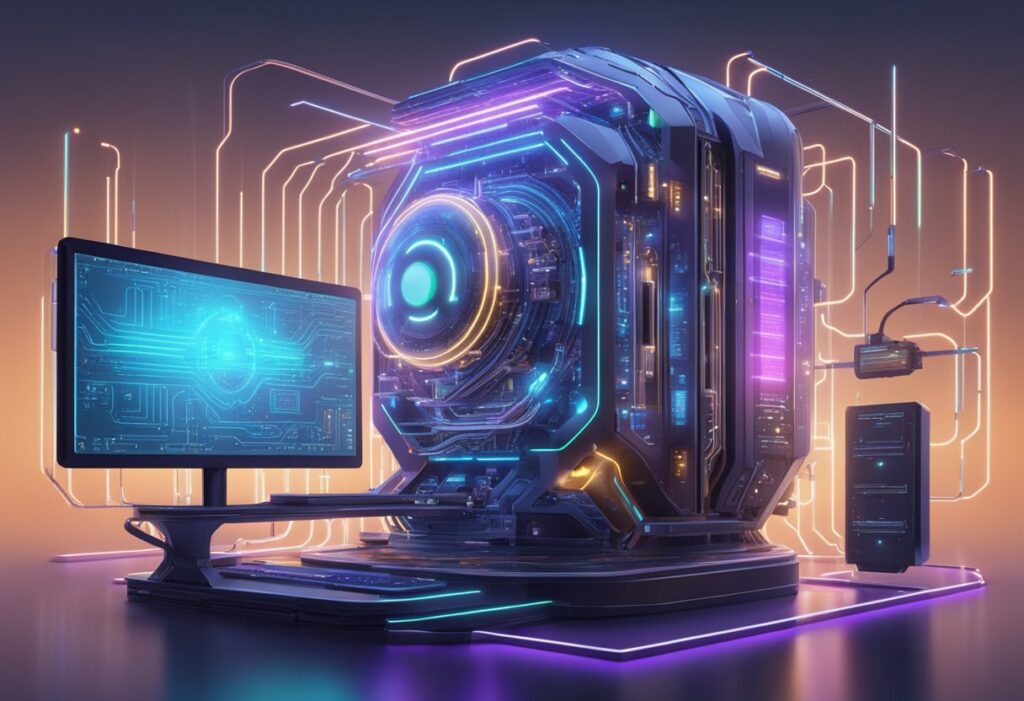The concept of the Metaverse has been around for several years, but it has gained renewed attention with the latest advancements in virtual reality technology. The Metaverse is a virtual space that is being developed as an extension of the internet, and it is envisioned as a fully immersive, three-dimensional environment where people can interact with each other in real-time. The Metaverse is seen as the future of the internet, and it is expected to revolutionize the way we communicate and interact with each other.
The Metaverse Machine is a term that has been coined to describe the infrastructure that will be required to support the Metaverse. The Metaverse Machine will be a complex network of servers, data centers, and other hardware that will be required to run the virtual world. The Metaverse Machine will need to be capable of supporting millions of users simultaneously, and it will need to provide a seamless and immersive experience to those users. The development of the Metaverse Machine is seen as a critical step in the development of the Metaverse, and it is expected to be a major focus of investment in the coming years.
Foundations of Metaverse Machines
Metaverse devices are hardware components that enable users to access and interact with the Metaverse. These devices include virtual reality headsets, augmented reality glasses, smartphones, tablets, and computers. Metaverse devices are equipped with sensors, cameras, microphones, and other components that allow users to see, hear, and interact with the virtual world.
Hardware Needed for Metaverse
Metaverse machines require high-performance hardware to render and display immersive virtual environments. The hardware includes powerful graphics cards, CPUs, and memory to handle the complex computations required for rendering. NVIDIA is one of the leading manufacturers of graphics cards used in Metaverse machines.
How Metaverse Machines Work
Metaverse machines use a combination of software and hardware to create immersive virtual environments. The software includes game engines like Unity and Unreal Engine, which provide the tools for developers to build virtual worlds. The hardware components, such as the graphics card and CPU, work together to render and display the virtual world in real-time.
Blockchain technology is also being integrated into Metaverse machines to enable decentralized ownership of virtual assets. Companies like Apple, Google, Microsoft, and Qualcomm are investing in Metaverse technology to create new revenue streams and enhance their existing products and services.
Metaverse machines are the foundation of the Metaverse, providing users with the hardware and software needed to access and interact with virtual worlds. With the support of major tech companies and the integration of blockchain technology, the Metaverse is poised to become the next major platform for social interaction, entertainment, and commerce.
The Metaverse Ecosystem
The Metaverse Ecosystem is a complex and rapidly evolving landscape, consisting of a wide range of players and platforms. This section will explore the major players and platforms, the economic landscape, and the social and cultural dynamics of the Metaverse.
Major Players and Platforms
The Metaverse is currently dominated by Meta Platforms (formerly Facebook), which has been investing heavily in the development of the Metaverse. Other major players include Roblox and Fortnite, both of which have established themselves as popular virtual worlds with large user bases.
Video game companies are also key players in the Metaverse ecosystem, with many of them developing games that are set in virtual worlds. Minecraft, for example, is a popular sandbox game that allows players to create and explore their own virtual worlds.
Economic Landscape
The Metaverse economy is still in its early stages, but it is already attracting significant investment from companies and investors. The global Metaverse market is expected to grow from $107.1 billion in 2020 to $758.6 billion by 2026, driven by applications offering workforce collaboration, product design and development, manufacturing, logistics, sales and marketing, and retail.
Brands are also starting to take notice of the potential of the Metaverse, with many of them exploring ways to establish a presence in virtual worlds. This includes everything from virtual storefronts to branded experiences and events.
Social and Cultural Dynamics
The Metaverse has the potential to fundamentally reshape social and cultural dynamics, by providing a new space for people to interact and collaborate. Social media platforms are already exploring ways to establish a presence in the Metaverse, with Meta Platforms in particular investing heavily in social features.
Governance is also an important issue in the Metaverse, with many virtual worlds establishing their own rules and regulations. Decentraland, for example, is a virtual world that is entirely governed by its users, with a decentralized system for decision-making.
The Metaverse ecosystem is a complex and rapidly evolving landscape, with significant potential for growth and innovation in the years to come.
User Interaction and Experience

Avatars and Virtual Identities
In the Metaverse, user interaction and experience are critical components that must be taken into account. Avatars and virtual identities are the primary means by which users interact with this virtual world. An avatar is a digital representation of a user that can be customized to reflect their preferences and personality. Users can create their avatars, which can be anything from a cartoon character to a realistic human representation.
The avatar is the user’s virtual identity, and it is what they use to interact with the Metaverse. Users can customize their avatars to reflect their personalities, including their clothing, hairstyle, and even their voice. The avatar is what the user uses to explore the Metaverse and interact with other users.
Content Creation and Distribution
Content creation and distribution are also critical components of the Metaverse. Users can create and share their content, including games, virtual worlds, and social experiences. The ability to create and share content is what makes the Metaverse so unique.
Users can create their virtual worlds, games, and experiences using various tools and software. They can then share their creations with other users, allowing them to explore and interact with the content. The content can be anything from a simple game to a complex virtual world with multiple levels and objectives.
User interaction and experience are critical components of the Metaverse. Avatars and virtual identities are the primary means by which users interact with this virtual world. Users can create their content, including games, virtual worlds, and social experiences, and share them with other users.
Real-World Applications and Implications
The metaverse is gaining popularity as a new way to experience the digital world. The concept of the metaverse is to create a shared virtual world that is analogous to the existing world. The metaverse is fueled by many emerging technologies, such as fifth-generation networks, virtual reality, and artificial intelligence (AI). The metaverse is a hypothetical, immersive 3D environment where people can experience life in ways they would not be able to in the physical world.
Business and Work
The metaverse has many potential applications in the business and work world. It can be used to create a virtual office that allows employees to collaborate and work together remotely. The metaverse can also be used to hold virtual meetings, which can increase productivity and reduce travel costs. The metaverse can help employees work more efficiently and effectively, as they can access all the tools they need in one place.
Education and Training
The metaverse can also be used in education and training. It can be used to create virtual classrooms where students can learn and interact with each other in a virtual environment. The metaverse can also be used to provide virtual training for employees, which can be more cost-effective and efficient than traditional training methods. The metaverse can help students and employees learn new skills and knowledge in a more engaging and interactive way.
Healthcare and Wellbeing
The metaverse can also be used in healthcare and wellbeing. It can be used to create virtual hospitals and clinics, where patients can receive medical care from anywhere in the world. The metaverse can also be used to provide virtual therapy and counseling, which can be more convenient and accessible for patients. The metaverse can help improve the quality of life for patients by providing them with access to healthcare and wellbeing services in a more convenient and efficient way.
The metaverse has many potential applications in various fields, including business, education, and healthcare. It can be used to create virtual environments that allow people to work, learn, and receive medical care in a more convenient and efficient way. The metaverse is still in the early stages of development, but it has the potential to revolutionize the way we experience the digital world.

Challenges and Future Directions
Privacy, Security, and Ethics
As the Metaverse machine becomes more integrated with people’s lives, there are growing concerns about privacy, security, and ethics. With the Metaverse machine, there is a risk of data collection and potential misuse of user data. The Metaverse machine can collect vast amounts of data on user behavior, which can be used for targeted advertising and other purposes. As a result, there is a need for strong privacy regulations to protect user data.
Moreover, the Metaverse machine raises ethical concerns about the potential for misinformation and manipulation. There is a risk that the Metaverse machine could be used to spread false information and propaganda, which could have serious consequences. To address these concerns, there is a need for clear ethical guidelines and regulations to ensure that the Metaverse machine is used responsibly.
Interoperability and Standards
Another challenge facing the Metaverse machine is interoperability and standards. The Metaverse machine is a complex system that involves many different technologies and platforms. As a result, there is a need for interoperability standards to ensure that different platforms can work together seamlessly.
Furthermore, there is a need for standards around spatial computing and generative AI. Spatial computing is the ability of computers to understand and interact with the physical world, while generative AI is the ability of computers to create new content. Standards in these areas will be crucial for the development of the Metaverse machine.
The Metaverse machine has the potential to revolutionize the way we interact with the digital and physical worlds. However, there are significant challenges that need to be addressed, including privacy, security, and ethical concerns, as well as interoperability and standards. Addressing these challenges will be crucial for the future development of the Metaverse machine.
Emerging Technologies and Trends
The Metaverse is an online world where users can interact with a virtual environment and other users. It is an emerging technology that is expected to revolutionize the way people experience digital content. The Metaverse machine is an advanced technology that is being developed to create a seamless virtual world. The Metaverse machine will be powered by a combination of emerging technologies and trends.
Extended Reality (XR) Innovations
Extended Reality (XR) is a combination of Virtual Reality (VR), Augmented Reality (AR), and Mixed Reality (MR). XR is expected to revolutionize human digital experiences and provide the entry points to the Metaverse. XR technologies will enable users to interact with the virtual world in a more immersive and realistic way. XR technology will be used to create virtual environments that are indistinguishable from the real world.
Blockchain and Digital Assets
Blockchain technology is a decentralized digital ledger that is used to record transactions. Blockchain technology is expected to play a significant role in the development of the Metaverse. Blockchain technology will be used to create digital assets that can be traded in the Metaverse. Non-Fungible Tokens (NFTs) are digital assets that are unique and cannot be replicated. NFTs are expected to play a significant role in the Metaverse economy.
Venture capitalists are investing heavily in the Metaverse. The Metaverse is expected to create a new digital economy that will be worth billions of dollars. The Metaverse will be powered by a combination of emerging technologies and trends. The Metaverse machine will be the key to unlocking the full potential of the Metaverse.
Frequently Asked Questions
How can I access the metaverse?
Accessing the metaverse requires a device that can connect to the internet and run metaverse software. There are several options available, including desktop computers, laptops, smartphones, and tablets. Most devices require a stable internet connection to operate smoothly. Once you have a device, you can download and install a metaverse application such as Second Life, VRChat, or Decentraland.
What are the costs associated with metaverse machines?
The cost of a metaverse machine varies depending on the device and software you choose. Some metaverse applications are free to download and use, while others require a subscription or one-time payment. Some devices may require expensive hardware, such as virtual reality headsets or high-end graphics cards, to run metaverse applications smoothly.
Which devices are optimal for experiencing the metaverse?
The optimal device for experiencing the metaverse depends on the user’s needs and preferences. Desktop computers and laptops generally offer the most processing power and flexibility but are less portable than smartphones or tablets. Virtual reality headsets provide a more immersive experience but require powerful hardware and may be uncomfortable for extended use. It is recommended to research the specific requirements of the metaverse application you plan to use before investing in a device.
What are the latest metaverse wearable technologies?
The latest metaverse wearable technologies include virtual reality headsets, augmented reality glasses, and haptic feedback devices. These devices aim to enhance the user’s experience by providing more immersive and realistic sensory feedback. Some popular examples include the Oculus Quest 2, Microsoft HoloLens 2, and Teslasuit. However, these devices may be expensive and require specialized software to operate.
Can you recommend any apps essential for navigating the metaverse?
Some essential apps for navigating the metaverse include Second Life, VRChat, Decentraland, and Mozilla Hubs. These applications offer a range of features, including virtual worlds, social interactions, and creative tools. It is recommended to research the specific features and requirements of each application before downloading and using them.
Where can I find a comprehensive guide to getting started in the metaverse?
There are several resources available for those looking to get started in the metaverse. Some popular options include online forums, social media groups, and tutorial videos. It is recommended to research the specific metaverse application you plan to use and seek out resources tailored to that platform. Many metaverse applications offer in-app tutorials and guides to help new users get started.














